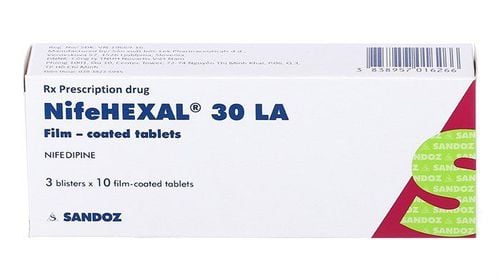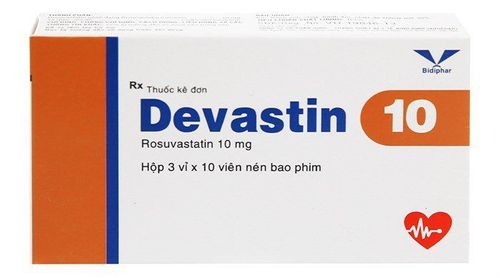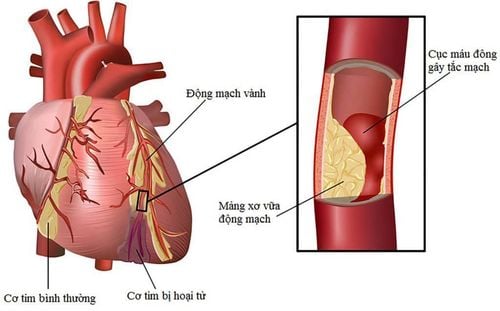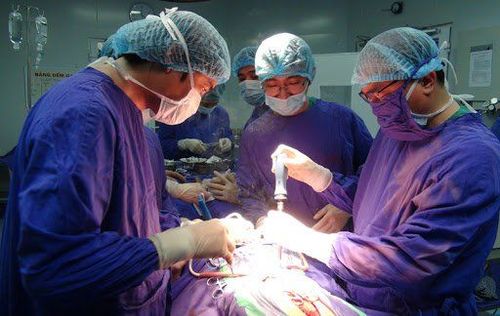This is an automatically translated article.
The article was professionally consulted by Doctor Vo Thanh Nhan - Cardiovascular Center - Vinmec Central Park International General Hospital.Coronary stenosis for a long time will lead to heart failure due to frequent myocardial ischemia and sudden occlusion will cause myocardial infarction, causing necrosis of an area of the myocardium, leaving many sequelae. serious for cardiovascular health such as heart failure, heart valve regurgitation, arrhythmia, even death.
1. Coronary narrowing easily leads to myocardial infarction
Coronary stenosis is a term that refers to a condition in which blood cannot reach the heart adequately due to narrowing of the blood vessels that supply the heart (coronary artery stenosis). The common cause of coronary artery stenosis is the presence of atherosclerotic plaque that adheres to the lumen of the vessel, causing an inflammatory reaction that can grow larger, narrowing the artery and when rupture easily leads to myocardial infarction. , threatening the patient's life.
Left angina is the most common and typical symptom of coronary artery stenosis, mainly occurs with exercise, emotion, cold. Feeling the pain like someone squeezing, twisting in the heart, the pain can spread to the jaw, forearm, arm and along the little finger of the left hand ... The pain usually lasts 5-10 minutes. , which usually resolves spontaneously with rest or supportive medication.
Some cases of elderly, diabetic, chronic obstructive pulmonary disease when coronary stenosis may not show typical symptoms of angina as above, but instead signs of fatigue or Shortness of breath on exertion. This is the reason why patients and their relatives pay little attention, leading to delay in diagnosis and treatment, until a heart attack occurs, it is too late.
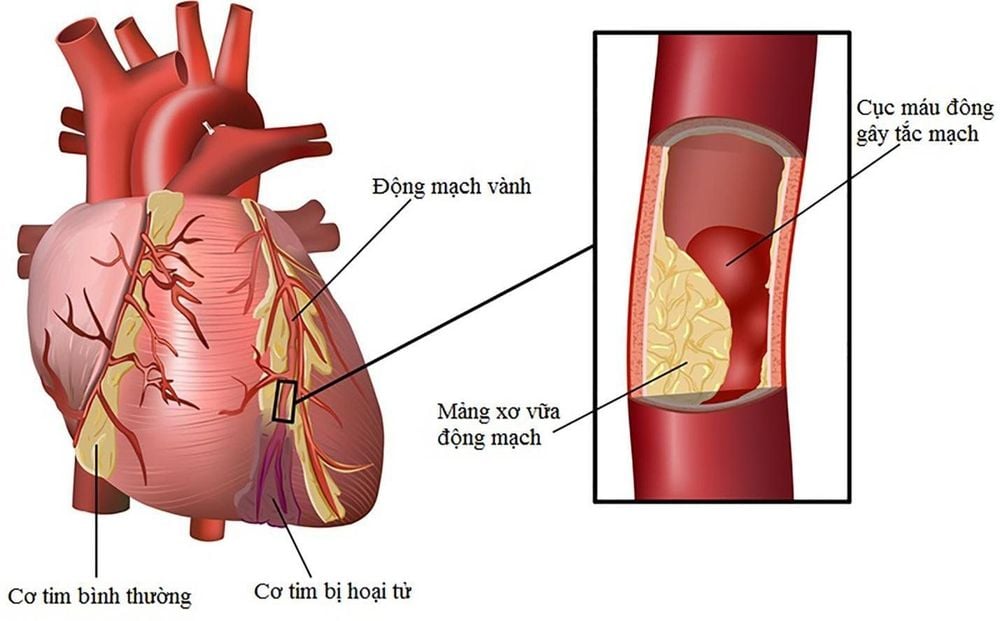
2. Patients with coronary artery stenosis need early intervention and treatment
When detecting coronary stenosis, the patient should be treated early by the following methods:
2.1. Treatment of coronary stenosis without medication Patients with coronary stenosis need to follow the doctor's instructions for non-drug treatment:
Food: The patient should have a reasonable diet as advised by the doctor. treatment, such as limiting the addition of too much energy, reducing animal fat (in egg yolk, animal fat). Exercise regularly: The level of physical activity depends on your physical condition, age and comorbidities. On average, you should exercise 30 minutes a day, regularly on weekdays. Adhere to the treatment regimen, especially for patients with high blood pressure, diabetes, dyslipidemia. 2.2. Medical treatment with drugs The use of drugs should be done under the direction of the doctor directly treating the patient:
Coronary vasodilator: Usually used when the patient has pain, before exercising (on the bridge). ladder, uphill). Antiplatelet: As the regular treatment for coronary stenosis, in the absence of peptic ulcer or gastrointestinal bleeding, preventing myocardial infarction. Beta-blockers: These are drugs that help reduce the risk of myocardial infarction but should be avoided in people with bradycardia (< 60 beats/minute), bronchial asthma... Fat-lowering drugs Statins: help reduce blood fat and stabilize atherosclerotic plaques. 2.3. Coronary stenting Coronary stenting is a low-bleeding method, usually indicated after coronary angiography. Through the catheter (catheter), the doctor will thread a small wire (containing a small balloon at the end) into the area of the narrowed artery. The balloon is then inflated to widen the lumen, and a stent is placed to keep the lumen from narrowing again. After placing the rack, the patient still has to adhere to taking the above treatment for the rest of the time.
2.4. Aortic bypass surgery This type of intervention is often used in cases of multivessel stenosis that cannot be dilated or supported. The doctor will connect the anterior and posterior segments of the stenosis with another branch of the blood vessel, to prevent blood flow from bypassing the narrowed segment and continuing circulation.

3. Stent intervention to treat coronary stenosis
Doctors usually recommend coronary stenting in the following cases:
Coronary artery stenosis is more than 70% on MSCT coronary angiography (multi-slice computed tomography) or interventional coronary angiography. In that case, stenting of the coronary artery should be performed. However, sometimes during an angiogram, doctors may use other techniques to further evaluate the narrowing before deciding to place a stent. Stable angina that cannot be resolved despite optimal medical therapy. Stable angina, with evidence of myocardial ischemia (e.g. positive myocardial perfusion scan or stress test) and involvement of the coronary artery supplying an area of muscle big heart. Unstable angina or signs of acute myocardial infarction without heart failure. Acute myocardial infarction with elevation of heart failure. Angina pectoris appeared after coronary artery bypass surgery. The patient had symptoms of coronary re-stenosis after percutaneous coronary intervention.
4. Advantages when performing coronary stenting at Vinmec
For patients with a history of heart disease, especially symptoms of myocardial infarction, it is necessary to conduct long-term treatment and have close monitoring from the doctor, especially the elderly. Symptoms come on quickly and occur suddenly, requiring intervention measures to avoid unnecessary harm.
Vinmec Central Park International General Hospital (HCMC) applies a full-service cardiovascular disease treatment model. This is a treatment modality being carried out at leading Cardiovascular Centers in the US and many other developed countries such as Mayo Clinic, Cleveland Clinic, Pennsylvania....
Cardiovascular Package Program (BUNDLE) PAYMENT ) will be applied with 1 of 4 techniques:
TAVI intervention Coronary interventional stenting Aortic bypass surgery Ventricular septal surgery Based on long-term treatment, the doctor will diagnose and check health, then advise the patient which technique is reasonable to use and sign a contract to use the appropriate package. The contract includes the treatment method, length of hospital stay, number of follow-up visits and a fixed cost that the patient has to pay for the duration of the treatment.
Package treatment model is one of the activities to realize the policy of "Patient is the center" at Vinmec International General Hospital. The outstanding advantages of the full-service cardiovascular treatment model at Vinmec Central Park include:
Multi-specialty treatment: Patients will have a comprehensive and thorough treatment plan by a multi-specialty team, coordinating from many fields; The treatment regimen is standardized according to the standards of prestigious cardiovascular associations in the world; Patients have direct access to the most appropriate and optimal regimen, avoiding the need to test many different treatment methods that are costly or reduce the effectiveness of treatment; Increase recovery, reduce hospital stay; Peace of mind about the treatment plan and proactive about treatment costs. Vinmec Central Park Cardiovascular Center is one of the key centers of Vinmec Health System, gaining JCI global certification. The center is invested with modern equipment and well-trained human resources, including many leading experts in the field of Cardiology such as:
Professor, Doctor, Doctor Vo Thanh Nhan: First expert Vietnam's pioneer in percutaneous aortic valve replacement (TAVI); pioneer in the implementation of new and specialized cardiovascular techniques: MitraClip, StentGraft... Dr., Doctor Nguyen Luong Tan : Expert in adult and pediatric cardiothoracic surgery. The doctor is well-trained in the country and many centers have the world's leading medical background such as: France, Australia... Master, Doctor Nguyen Duc Hien: Has more than 12 years of experience in the field of cardiology especially especially Cardiovascular and thoracic surgery.... Vinmec Central Park Heart Center has successfully treated over 98% of cases of TAVI intervention, open heart surgery, painless open heart surgery by combination ESP technique, effective even with severe and elderly cases. Vinmec Central Park is also the first hospital in Vietnam to be recognized as an independent American standard TAVI intervention center.
Please dial HOTLINE for more information or register for an appointment HERE. Download MyVinmec app to make appointments faster and to manage your bookings easily.






